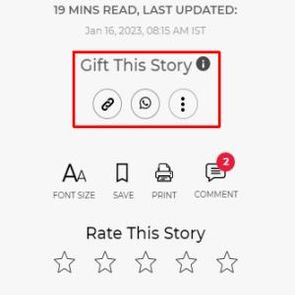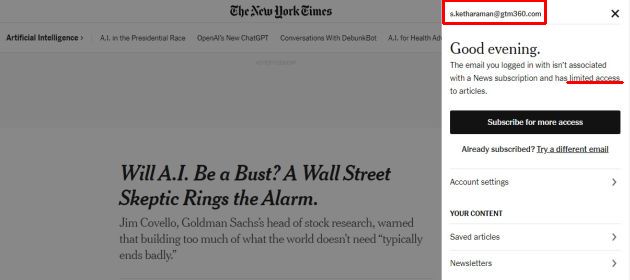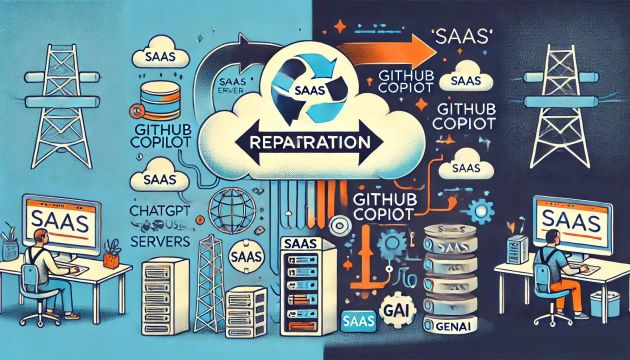People don’t want to buy subscriptions just to read the one odd article. But they’re happy to pay 10 cents or 10 rupees to read an individual article in their favorite publications. UPI and other A2A RTP methods of payments now make it easy to make such small value payments.
Still per article sales is not a thing.
I speculated in Why Publishers Don’t Sell Individual Articles that the constraint is not on the demand-side or with micropayments but on the supply-side: Put simply, publishers don’t wish to sell individual articles.
In Musk Twitter Will Take Per Article Sales To The Next Level, I predicted that X fka Twitter will change that. A year later, the buzz around Twitter Money, the micropayment that was touted to enable the sale of individual articles, has died. It’s not yet possible to buy single articles on Twitter. My post has aged badly.
Paywall is still a thing on Bloomberg, ET Prime, New York Times, Wall Street Journal, Washington Post and other leading publications of the world.
But despair not. There are many ways to scale the paywall.
1. Social Media Backdoor Link
You might have come across very long URLs like
https://economictimes.indiatimes.com/prime/corporate-governance/how-a-little-known-delhi-based-company-bought-nasdaq-listed-ebix-out-of-bankruptcy/primearticleshow/113675485.cms?giftid=q7v19pdhaic53yod3pgd0jtbyoe6a5z3&utm_medium=social&utm_campaign=socialsharebuttons&utm_source=clipboard_web.
They provide a backdoor to the article without hitting a paywall. The crud after the ? sign looks ugly but don’t delete it.
PSA: URL tracking codes are annoying but, before deleting them indiscriminately, remember that some of them provide free access to premium content e.g. WSJ Social Backdoor Link.
— Ketharaman Swaminathan (@s_ketharaman) May 16, 2018
 Since these links are typically circulated via X fka Twitter, LinkedIn and other social networks, this hack is called Social Media Backdoor. You can get them from two sources:
Since these links are typically circulated via X fka Twitter, LinkedIn and other social networks, this hack is called Social Media Backdoor. You can get them from two sources:
- Author: Authors of many articles post these links on Twitter. If you follow them, you can get paywall-free access to their articles.
- Subscriber: Subscribers of many news sites get gift links that provide 20-25 free views. Like me, they post them on Twitter and / or LinkedIn. The fastest finger to click those links gets to read the article without encountering any paywall.
2. Incognito Mode
Sometimes visiting the article’s page in incognito mode of browser gets past the paywall.
3. Registration
Some publishers give free access to certain certain number of articles if you register yourself on their websites. I’ve known this about MEDIUM in the past.
Recently, I learned that it’s also a thing on New York Times. I read an article (without encountering a paywall) but, when I shared the link on a WhatsApp Group, others complained that they got blocked.
When I looked closely, I found out that the nytimes.com website had logged me in automatically and, since I was presumably within my quota of free articles for that month, I didn’t see a paywall whereas the others hadn’t registered and got blocked. (When I’d bought an NYT subscription a few years ago, I’d created an account, and forgot about it until this incident).
4. Archive Extension
Archive Page is a nifty Chrome Extension that provides free access to archived pages of articles. In my experience, it works on some popular news sites like New York Times, Washington Post and Wall Street Journal but not on others like The Information and ET Prime. Lately, its reCAPTCHAs have become very difficult to crack but light users may not be gated by a CAPTCHA.
5. Google Backdoor
Woz a time when you saw a paywall if you visited the article webpage directly but, if you Googled the title of the article, the link in the search result would take you behind the paywall. I’ve covered this hack in detail in Why Pay For Content When You Can Get It For Free?. I wrote that post in 2012. This hack rarely works nowadays but I’m putting it out here for the sake of completeness.
6. Syndicated Publishers
While the hyperlink to the original website on the Google SERP might not work, many articles are syndicated on other publications and the SERP will contain entries of alternative websites. If you click one of them, you might be able to get past the paywall.
Given below are two examples:
(6.1)
TIL NYT articles that are behind the paywall on https://t.co/fAsrzSd3rI are available to everyone on other media websites. e.g. Buyers of Amazon devices are guinea pigs and that’s a problem.
Paywall: https://t.co/qfvuXstax4
Free: https://t.co/V0u9ZEdbcK ;https://t.co/SAMCFIPYo5— GTM360 (@GTM360) July 13, 2021
(6.2)
The same article that’s free on FASTPAGE website is locked up behind a paywall on MEDIUM website. #GoFigure . I’m reminded of https://t.co/PvD43hCFGP .https://t.co/JC5LiP2StZ ;https://t.co/InlXLDdImH .
— Ketharaman Swaminathan (@s_ketharaman) August 24, 2020
7. ChatGPT Backdoor
I happened to ask ChatGPT to summarize a news article around the time that OpenAI went into a meltdown with the firing of Sam Altman. It not only gave a summary but provided a link to the article. When I clicked it, I could read the article without being blocked by a paywall.
Stumbled upon yet another paywall bypass hack: Ask ChatGPT to summarize an article. ChatGPT 3.5 keeps saying it cannot access the Internet but somehow this works. pic.twitter.com/NRFRrAv33r
— Ketharaman Swaminathan (@s_ketharaman) December 12, 2023
When I tried this hack a couple of days after after Sam Altman was reinstated, it didn’t work. From that, I’m inferring that this hack may not work under normal conditions. However, the sudden resignation of three top executives of OpenAI recently might trigger the next meltdown of OpenAI anytime, so I’m putting this hack out here FWIW.
8. Coquettish Article
Search for the coquettish article and speed read it before it covers itself with a paywall.
Coquettish Article Allowing One Tempting Glimpse Before Covering Itself With Paywall https://t.co/DdSF5RWGvT pic.twitter.com/JJps0xplsL
— The Onion (@TheOnion) September 15, 2020
I hope to continuously update this post with any new hacks that I find. Meanwhile, if you know of any more hacks, please share them in the comments below. Thanks in advance.
DISCLAIMER: None of the above hacks is guaranteed to work. Just because something is technically feasible does not mean it’s kosher per publisher’s TOS or law of the land. We take no responsibility for the consequences of your use of these hacks. In short, Do Your Own Research.
Content is in Public Domain if it (1) can be freely accessed (without micropayment, paywall, subscription) (2) used & distributed by anyone without any restrictions, and (3) does not have Intellectual Property Rights (IPR).
tl;dr: Publicly available ? In public domain.— GTM360 (@GTM360) July 22, 2024


